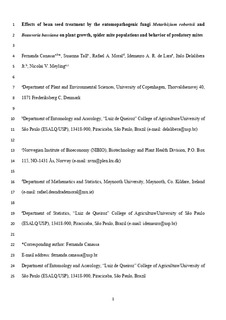| dc.contributor.author | Canassa, Fernanda | |
| dc.contributor.author | Tall, Susanna | |
| dc.contributor.author | Moral, Rafael de Andrade | |
| dc.contributor.author | de Lara, Idemauro A.R. | |
| dc.contributor.author | Delalibera Jr., Italo | |
| dc.contributor.author | Meyling, Nicolai Vitt | |
| dc.date.accessioned | 2019-11-11T13:40:48Z | |
| dc.date.available | 2019-11-11T13:40:48Z | |
| dc.date.created | 2019-06-12T14:54:49Z | |
| dc.date.issued | 2019-02-06 | |
| dc.identifier.citation | Biological control (Print). 2019, 132 199-208. | nb_NO |
| dc.identifier.issn | 1049-9644 | |
| dc.identifier.uri | http://hdl.handle.net/11250/2627758 | |
| dc.description.abstract | The fungal genera Metarhizium and Beauveria are considered as both entomopathogens and endophytes; they are able to colonize a wide variety of plants and can cause increased plant growth and protect plants against pests. In view of the need for new biological methods for plant protection and how promising and little studied candidates entomopathogens are, the aim of this research was to evaluate the potential of two isolates of Metarhizium robertsii (ESALQ 1622) and Beauveria bassiana (ESALQ 3375) to suppress spider mite Tetranychus urticae population growth and ability to promote growth of bean plants Phaseolus vulgaris after seed treatment, in order to develop an innovative strategy by using these fungi as inoculants to improve both spider mites control and plant growth and yield. In addition, behavioral responses and predation rates of the predatory mite Phytoseiulus persimilis towards fungal treated plants and spider mites from these plants were also evaluated in leaf disc assays to assess potential conflicting effects of the fungal inoculations on overall pest control at higher trophic levels. Seed inoculations by the two isolates of M. robertsii and B. bassiana were done individually and in combinations to evaluate potential benefits of co-inoculants. The results showed a significant reduction in T. urticae populations and improved plant development when inoculated with M. robertsii and B. bassiana individually and in combination. The predatory mite P. persimilis showed no difference in the predation rate on T. urticae from treated and untreated plants even though the predators were most likely to feed on spider mites from fungal treated plants during the first half of the trial, and on spider mites from control plants during the remainder of the trial. Overall, the two fungal isolates have potential as seed inoculants to suppress spider mites in bean and the strategy appears to have no conflict with use of predatory mites. Co-inoculation of both fungal isolates showed no additional benefits compared to single isolate applications under the given test conditions. | nb_NO |
| dc.language.iso | eng | nb_NO |
| dc.subject | Endophytes | nb_NO |
| dc.subject | Biological control | nb_NO |
| dc.subject | Tetranychus urticae | nb_NO |
| dc.subject | Plant growth | nb_NO |
| dc.subject | Phytoseiulus persimilis | nb_NO |
| dc.title | Effects of bean seed treatment by the entomopathogenic fungi Metarhizium robertsii and Beauveria bassiana on plant growth, spider mite populations and behavior of predatory mites | nb_NO |
| dc.type | Journal article | nb_NO |
| dc.type | Peer reviewed | nb_NO |
| dc.description.version | acceptedVersion | nb_NO |
| dc.rights.holder | © 2019 Elsevier Inc. All rights reserved. | nb_NO |
| dc.subject.nsi | VDP::Landbruks- og Fiskerifag: 900 | nb_NO |
| dc.source.pagenumber | 199-208 | nb_NO |
| dc.source.volume | 132 | nb_NO |
| dc.source.journal | Biological control (Print) | nb_NO |
| dc.identifier.doi | 10.1016/j.biocontrol.2019.02.003 | |
| dc.identifier.cristin | 1704407 | |
| dc.relation.project | Norges forskningsråd: 244526 | nb_NO |
| dc.relation.project | Andre: 19/2016 - CAPES/PDSE | nb_NO |
| dc.relation.project | Andre: 04/2016 - Mobilidade Santande | nb_NO |
| cristin.unitcode | 7677,3,0,0 | |
| cristin.unitname | Divisjon for bioteknologi og plantehelse | |
| cristin.ispublished | true | |
| cristin.fulltext | postprint | |
| cristin.qualitycode | 1 | |
